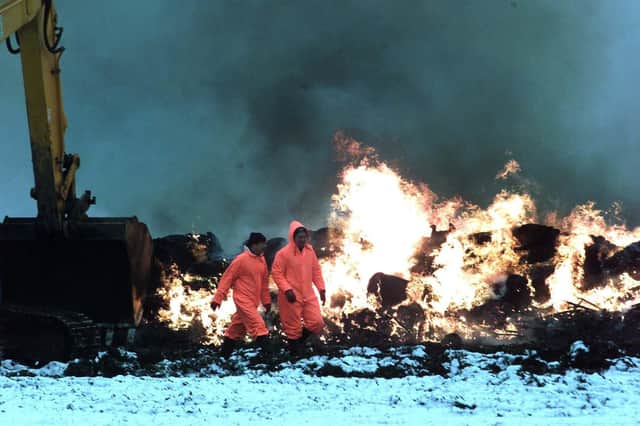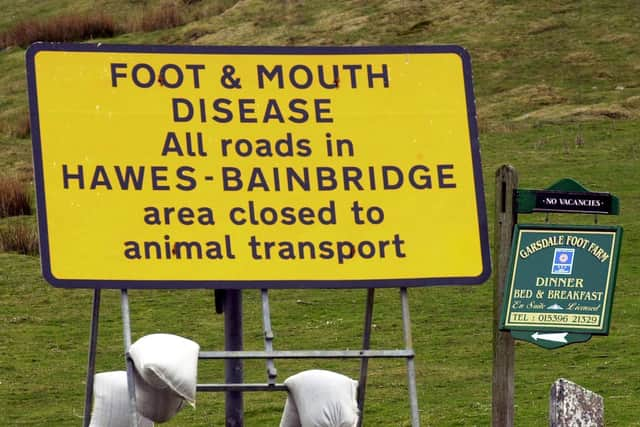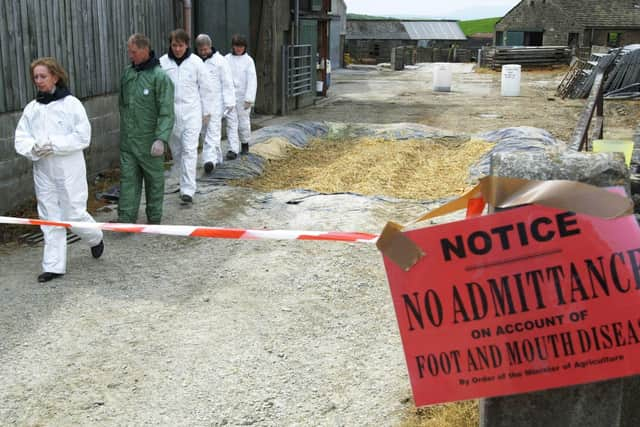Two decades on, we’re still counting the terrible cost of foot and mouth


The year just ending is the one that will be forever associated with disease and infection spreading out of control. But the coming weeks will see the 20th anniversary of another lockdown across Britain, an epidemic with many parallels, not least in the toll it took on those involved.
The largest outbreak of foot and mouth in Britain since the 1960s led to the culling of more than six million cattle, sheep and pigs – around one in eight of all farm animals – and wiped billions from the economy.
Advertisement
Hide AdAdvertisement
Hide AdThose were the headline statistics, but they failed to account for the lambs and calves that were only a few days old when the slaughterers came, and were not counted in the official tally. Nor do they tell of the human misery in agricultural communities as livelihoods were threatened and the old certainties of life upended.


“It’s often forgotten how impactful it was on farmers for that short, sharp time,” said Dr Julia Meaton, of Huddersfield University, who lived at the time in a rural Pennine hamlet where farmers were forced to close their footpaths for fear of outsiders carrying the infection on the soles of their boots.
Comparisons with Covid were inevitable, she said. But whereas the current virus is invisible, the signs foot and mouth were all too obvious.
“The pyramids, the pyres that were on the news were right outside farmers’ front doors. Every time they went out, the noises of the shots, of the animals being killed, took a massive toll – not just on their livelihoods but because they were losing everything they held dear.”
Advertisement
Hide AdAdvertisement
Hide AdThe first reported case was at an abattoir in Essex in February 2001 – though it later emerged that there had already been an outbreak in the north-east. A pig farmer there was convicted of failing to alert the authorities.


The Government’s contingency plans, drawn up 34 years earlier in an age before mass transport, anticipated 10 more outbreaks at most, but within a week there were further cases as far away as Devon and Northumberland, and a few days later – despite the first mass slaughter – the disease was confirmed in Cornwall and Scotland, too.
It took nine months to bring the spread under control, at an estimated cost to taxpayers of £3bn and a further £5bn to agriculture. Tourism business lost trade estimated at £250m.
Farmers received more than £1.1bn in compensation for animals slaughtered for disease control purposes, but many suffered consequential losses for which they were not compensated.
Advertisement
Hide AdAdvertisement
Hide AdThe speed at which foot and mouth escalated out of control, and the response of ministers, raised questions about their competence and that of their departments, and about the future of farming itself. Meanwhile, the general election was postponed and countless events – the Great Yorkshire Show included – cancelled.
The source was never conclusively traced, but the theories have a familiar ring. Some said it came from Asia and arrived in the UK via South Africa, perhaps in illegally imported meat.
“It exposed complex supply chains in the food industry that people almost weren’t aware of, and of which hardly anybody was taking seriously,” said Dr Meaton.
“It showed the vulnerability of the system, and demonstrated that while that kind of connectivity was very good in terms of keeping prices down and guaranteeing access to resources, it had a dark side as well. Animals were being transported up and down the country with very little governance.”
Advertisement
Hide AdAdvertisement
Hide AdShe added: “The theories about Covid emanating from a wet market in Wuhan remind us that we’re still playing catch-up in dealing with the growth of our connectivity.”
Two decades on, Britain is better placed to avoid a repeat of 2001, Dr Meaton said. But the experience of Covid demonstrated there was no room for complacency.
“I hope we have learned enough to prevent another outbreak of foot and mouth,” she said. “Food safety has vastly improved in the last 20 years. The way we monitor animal transport is much stronger and more robust. But we never fully learn from what has gone on before.”
No-one knows if the scars have fully healed.
“Most farmers did recover. They got on with it and lived to farm another day, but there were longer-term mental health issues,” Dr Meaton said.
Advertisement
Hide AdAdvertisement
Hide Ad“It’s hard to know if there are still people who were traumatised by what happened 20 years ago. We talk more about mental health now than we did then. Perhaps foot and mouth contributed to that.”
• There were more than 2,000 confirmed cases of foot and mouth in 2001. At the peak of the epidemic in late March, around 50 cases were being reported every day.
The disease was eradicated within two months in around half the infected areas. But the epidemic was not declared over until much later in the year, after three “clear” months.
The National Audit Office later criticised officials for not imposing a national ban on the movement of animals earlier in the outbreak, and for not taking into account the effect on tourism following the blanket closure of many footpaths.
Advertisement
Hide AdAdvertisement
Hide AdSupport The Yorkshire Post and become a subscriber today. Your subscription will help us to continue to bring quality news to the people of Yorkshire. In return, you’ll see fewer ads on site, get free access to our app and receive exclusive members-only offers. Click here to subscribe.
Comment Guidelines
National World encourages reader discussion on our stories. User feedback, insights and back-and-forth exchanges add a rich layer of context to reporting. Please review our Community Guidelines before commenting.